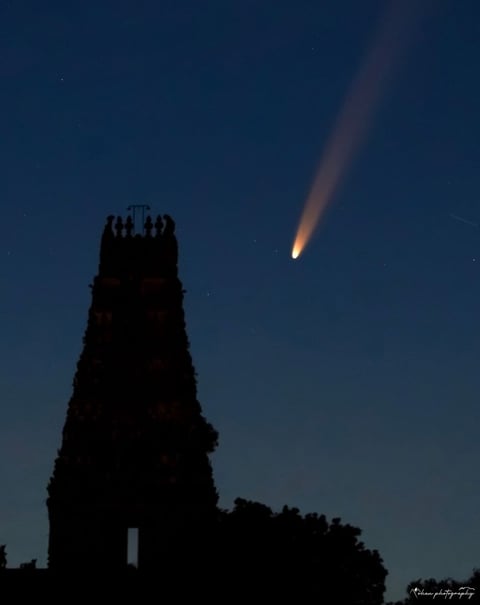Comets
SCIENCE
Nitin Karthik
10/15/20244 min read
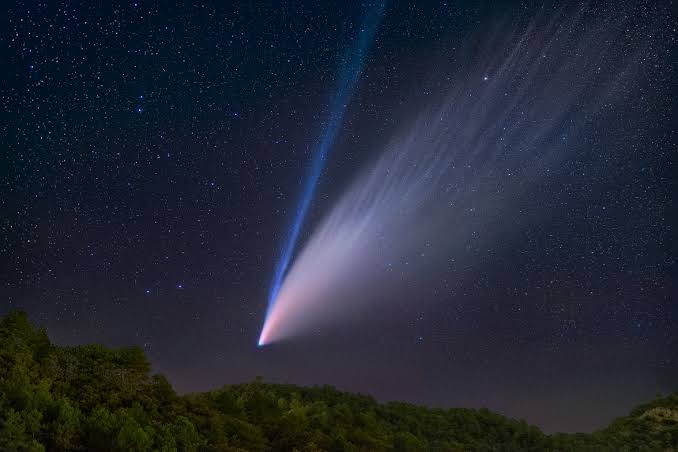

What are Comets?
Comets are frozen leftovers from the formation of the solar system composed of dust, rock, and ice. They range from a few miles to tens of miles wide, but as they orbit closer to the Sun, they heat up and spew gases and dust into a glowing head that can be larger than a planet. This material forms a tail that stretches millions of miles. Some of these relatives visit us from the distant suburbs of our solar system, from a place beyond the last orbit of Pluto in the Kuiper belt, known as the ‘Oort Cloud’, named after the Dutch astronomer Jan Oort, who predicted its existence in the 1950s. The Oort Cloud is a spherical shell that embraces the entire solar system and is estimated to be housing over a trillion comets and other objects and is as far away from the Sun as 2,000 (inner edge) – 100,000 AU (outer edge). 1 AU (Astronomical Unit) is the Earth-Sun distance of about 150 million km.
Tsuchinshan-ATLAS/The Purple Mountain Comet.
Most of us would be aware of the Comet Halley discovered in the 18th century, which is a periodic comet appearing to us, every 76 years. Some of the comets can also be long period, that take more than 200 years to orbit the Sun, which means we will never be able to see them more than once in the same place in our lifetime. One such Comet, astronomically designated ‘C/2023 A3 (Tsuchinshan-ATLAS)’ is currently dropping by to say “Hi” to all of us here on Earth. It was discovered by the Purple Mountain Observatory in China on 9th January 2023 and was also independently observed by ATLAS (Asteroid Terrestrial-impact Last Alert System), South Africa about a month later on 22nd February, 2023.


How Comets orbit the Sun.
Comets have an extremely elongated circular (elliptical) orbit which means they can be as far away from the Sun as the outermost edge of the Oort Cloud and could also get pretty close to the Sun, inside the orbit of the planet Mercury. These dramatic distances will translate into speeds and the closer you are to the Sun, the faster you orbit it, so these comets travel very swiftly when they are in the inner solar system while they quietly settle into a snail’s pace during their trip back to where they came from. They leave a trail of dust in their wake and when and if Earth intercepts with this dust, they enter our atmosphere and vaporize, creating spectacular meteor showers!
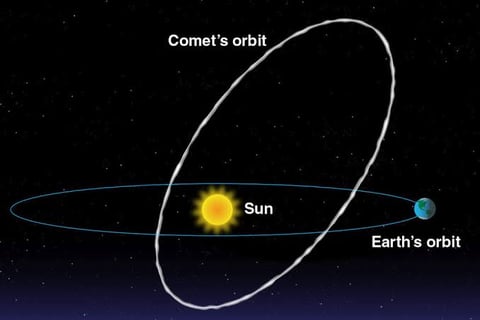

Does a Comet have two Tails?
A Comet is generally made up of four visible parts: Nucleus, Coma, Ion tail, Dust tail. The Nucleus is a solid object typically a few miles across and is made up of a mixture of volatile ices (mostly water ice), silicate and other dust particles. The Coma (Cometary Atmosphere) is the freely escaping atmosphere around the nucleus that forms when the comet comes close to the Sun and the volatile ices sublimate, carrying dust particles with them. The Dust tail forms from these dust particles and is blown back by solar radiation pressure to form a long curving tail that is typically white or yellow in color. The Ion tail forms from the volatile gases in the coma when they are ionized by ultraviolet radiation from the Sun and blown away by the solar wind. Ion tails point almost exactly away from the Sun and glow bluish in color.
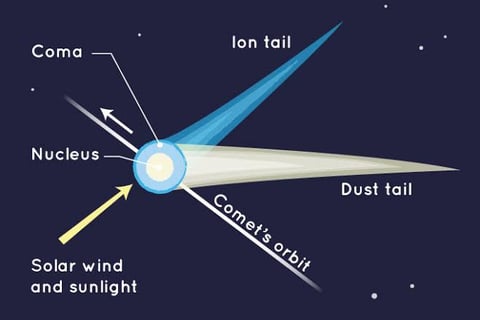

Visibility of Comets.
Contrary to popular belief, comets don’t whiz by in the sky just like that, as you stand in awe looking at them. Even when they are wandering in the inner solar system, there is still plenty of distance between us and them. So, they behave as any other astronomical object (The Sun, Moon, other planets, stars) would do, which means they rise in the East, march through the sky’s dome and set in the West. The visibility of a comet depends on how much sunlight it reflects to us, particularly the Dust tail. Any object with an Apparent Visual Magnitude (m) of +6 or under can be spotted with unaided eyes ideally but weather and clouds will play a part. The object gets brighter and brighter as the value of m decreases, including negative scales. For context, the Sun has ‘m’ of -26.7, the Full Moon has -12.6, planet Venus has -4.6 at its brightest.
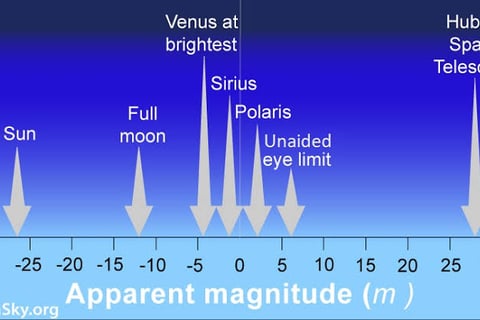

How to spot Tsuchinshan-ATLAS?
Early estimates of the Purple Mountain Comet pointed that it had an orbital period of about 80,000 years and a weak hyperbolic orbit which means due to its gravitational interactions with the Sun during its closest approach to the star (27th September, 2024), there is a small possibility that it could be slingshot by the Sun itself out of the solar system and the Comet may not come back at all. The Comet will have its closest approach to Earth on 12th October 2024 at a distance of 71 million km and after that it will transition into the evening sky and start becoming visible just after sunset, fairly low in the West, for a few days until late October. During this time, it is estimated to reach a visual magnitude of -3.5 which means it can potentially outshine the brightest stars and some of the planets in the sky and be easily visible to the naked eyes!
